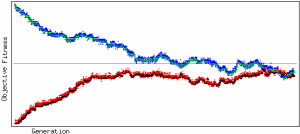
|
Why and How Evolution Stops Richard A. Watson Jordan B. Pollack Simulations and web page by Dmitri David Krasik The paper uses several simple 'number games' to illustrate three important coevolutionary tie-ups. The experiments from the paper are provided in the simulator. What follows is a page by page explanation of the different experiments. Read the explanation, study the graph and then click on it to run the simulation dynamically. The experiments use two coevolving populations where the members of each population play against members of the other population. We use a very simple representation of an individual (an integer or integer array) in the populations, and a very simple game (comparing which integer is bigger), to illustrate several ways in which coevolutionary dynamics may fail to evolve good strategies. Different dynamics in the coevolving populations can be observed by changing properties of the game and characteristics such as how many opponents are sampled in each population. The game is played between the members of two populations and based on some goal such as being larger, or having the dimension that most differs between opponents decide the game. In the experiments we are interested in comparing how the coevolving players 'think' they are doing according to the score they get against opponents, and how they are 'really' doing in regard to objective improvement (in our case this is the size of the number) - we use the terms 'subjective fitness' and 'objective fitness' to refer to these different measures. So, coevolutionary failure occurs where players fail to improve objectively despite continually playing against one another and selecting future progeny based on subjective fitness (what score you get versus the opponents). |
The fun starts soon, but first a note about mutation bias [ Experiment
0 - control experiment]
|
` |
 |